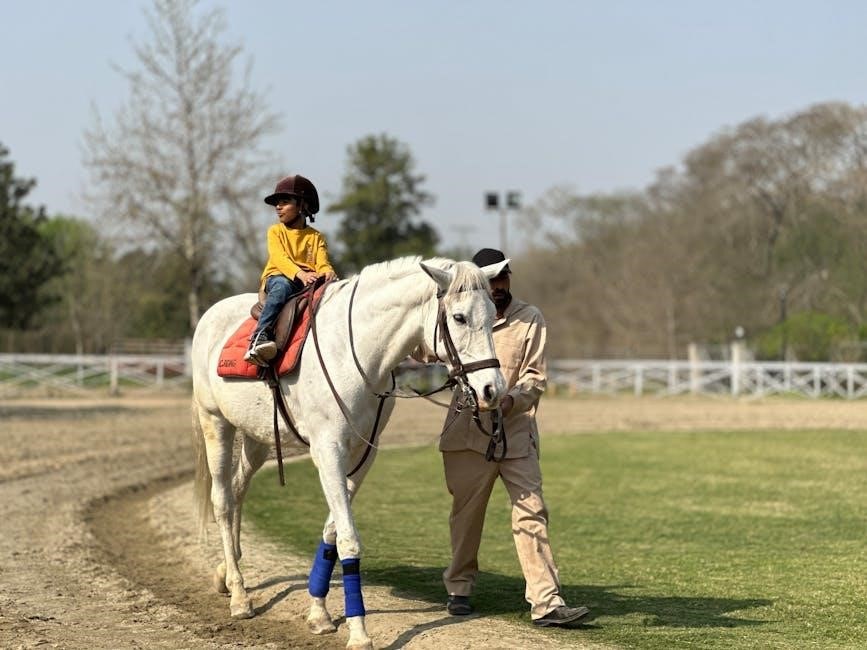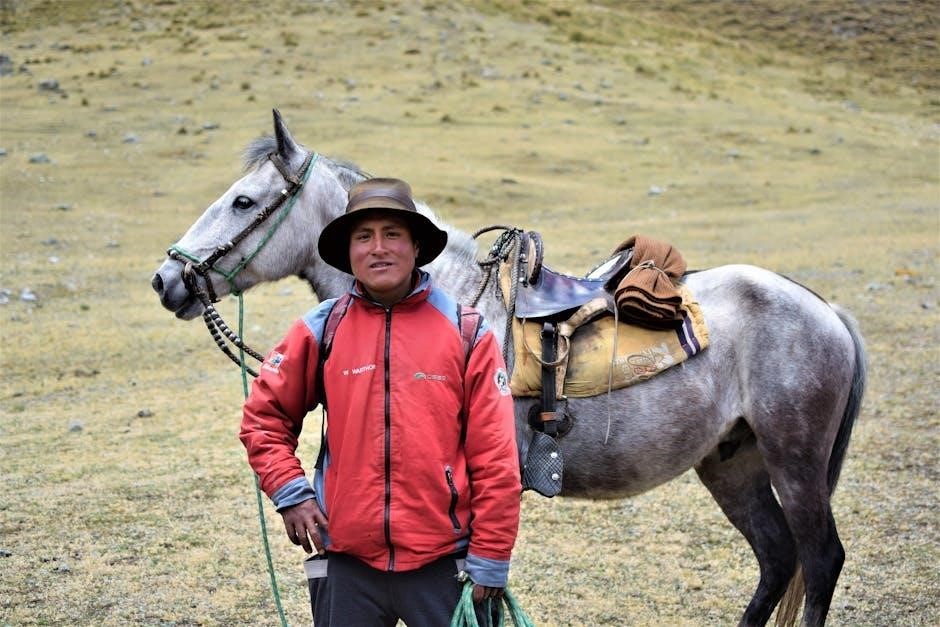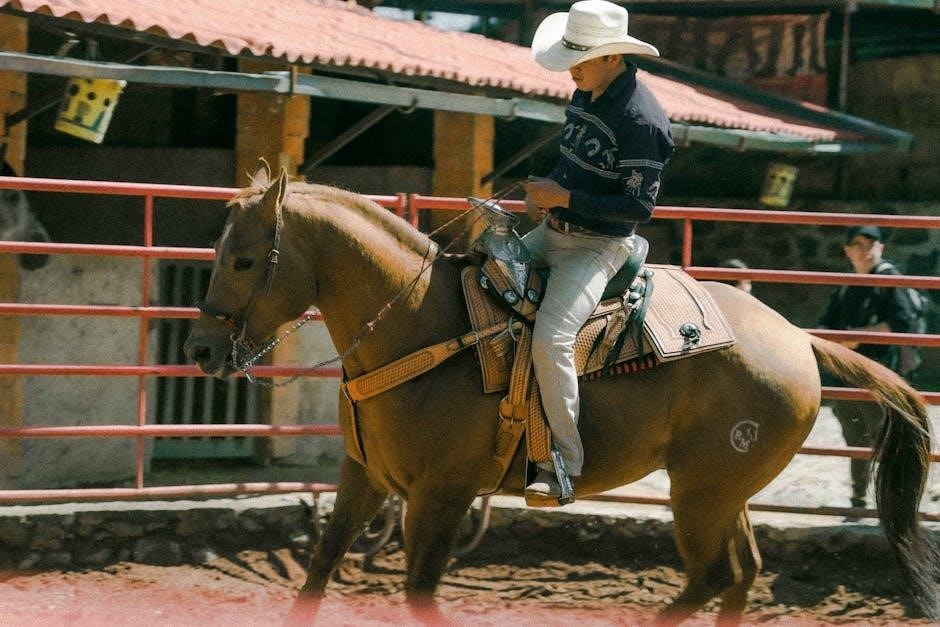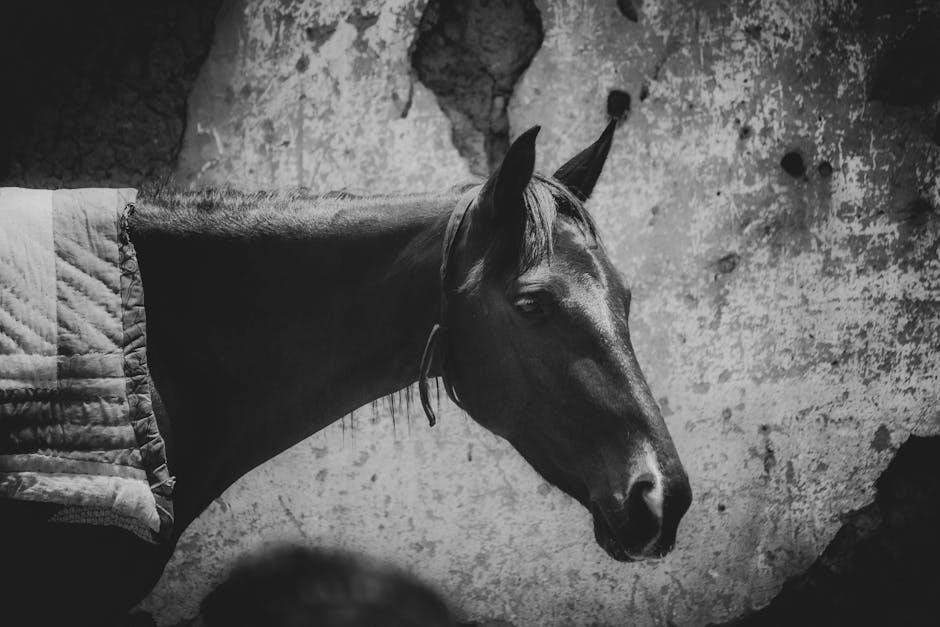Horse blanketing is essential for protecting horses from cold weather and managing their comfort. It involves using specifically designed blankets to keep horses warm and dry.
Why Horse Blanketing is Important
Horse blanketing is crucial for maintaining a horse’s body temperature, preventing heat loss, and ensuring comfort. It aids older or unhealthy horses and protects against harsh weather conditions like rain and snow. Blanketing helps prevent shivering, which can lead to energy loss and stress. It also supports normal behavior, as cold horses may reduce movement and eating. However, not all horses need blanketing; those with heavy coats in mild climates might overheat. The right blanket choice depends on temperature and individual needs, balancing protection without overloading. Proper blanketing ensures horses stay warm, dry, and comfortable, preserving their health and well-being.
Understanding Horse Blanketing Basics
Understanding horse blanketing basics involves knowing the types of blankets and their purposes. Lightweight sheets provide minimal warmth, while midweight and heavyweight blankets offer more insulation. Waterproof turnout blankets protect against rain and snow, and stable blankets are designed for indoor use. Proper fit is essential to ensure mobility and prevent rubbing. Blankets are typically measured by the horse’s chest, shoulder, and rump to ensure a snug but comfortable fit. Material choices vary, with options like cotton, polyester, and waterproof fabrics. Durability and breathability are key considerations to prevent overheating. Regular monitoring of the horse’s condition and weather conditions helps determine the best blanketing strategy. This foundational knowledge ensures effective and safe blanketing practices.
Factors to Consider Before Blanketing Your Horse
Climate, coat type, age, health, and individual needs are key factors. Assessing these ensures proper protection and comfort for your horse during varying weather conditions.
Climate and Temperature Guidelines
Climate and temperature play a crucial role in determining when to blanket your horse. In general, horses may need blanketing when temperatures drop below 40°F (4°C), especially if they have a thin coat. However, factors like humidity, wind, and rain can make it feel colder, so waterproof turnout blankets are essential. In warmer climates, lightweight sheets might be sufficient. Always monitor weather forecasts to adjust blanketing accordingly. Overheating can be harmful, so ensure your horse’s blanket matches the weather conditions. Proper layering and observation of your horse’s comfort are key to avoiding distress.
Horse Coat Type and Thickness
A horse’s coat type and thickness are vital in deciding the appropriate blanket. Horses with thin or clipped coats typically require more insulation, while those with thick, natural coats may need less. Age and health conditions also influence coat thickness; older or sick horses often have thinner coats and may need extra warmth. Additionally, some breeds naturally grow heavier coats, reducing the need for heavy blanketing. Always assess your horse’s individual coat condition to choose the right blanket weight, ensuring comfort and preventing overheating. Monitoring seasonal coat changes helps determine when to switch between lightweight and heavier blankets.
Age and Health Conditions
A horse’s age and health play a significant role in determining blanketing needs. Young foals, senior horses, and those with medical conditions often require extra care. Elderly horses may struggle to maintain body heat due to reduced metabolism and thinner coats, necessitating warmer blankets. Similarly, horses with health issues like Cushing’s disease or arthritis may need additional insulation for comfort. Always consult a veterinarian to tailor blanketing strategies for horses with specific health needs, ensuring their well-being without risking overheating. Proper blanketing can significantly improve their quality of life during colder months by providing necessary warmth and support.

Types of Horse Blankets
Horse blankets vary in weight, material, and purpose, offering options like lightweight sheets, midweight blankets, heavyweight blankets, waterproof turnout blankets, and breathable stable blankets.
Lightweight Sheets
Lightweight sheets are ideal for cooler weather or as a base layer under heavier blankets. They provide minimal warmth without restricting movement, making them perfect for horses with medium to heavy coats. These sheets often feature breathable materials to prevent overheating and are designed to protect against wind or light rain. They are versatile and can be used both in the stable and during turnout, ensuring your horse stays comfortable without feeling weighed down. Lightweight sheets are a practical choice for transitioning seasons or for horses that do not require heavy insulation but still need some protection from the elements. They are easy to clean and maintain, making them a popular option among horse owners. Additionally, they can be layered with other blankets for added warmth during colder months, ensuring your horse’s comfort in various conditions. By choosing a lightweight sheet, you can provide your horse with the right amount of coverage without overblanketing, which is crucial for their health and well-being. This makes lightweight sheets a must-have in every horse owner’s wardrobe for their equine companion. They are available in different styles and materials, so you can select the one that best suits your horse’s specific needs. Overall, lightweight sheets are an essential component of a well-rounded horse blanketing strategy, offering both functionality and flexibility for different situations. Their durability and ease of use make them a worthwhile investment for any horse owner looking to keep their horse comfortable and protected throughout the year.
Midweight Blankets
Midweight blankets offer a balance of warmth and versatility, making them suitable for moderate weather conditions. They typically have a fill power of 180-200 grams, providing adequate insulation without being too heavy. These blankets are ideal for temperatures ranging from 40°F to 55°F, depending on the horse’s coat thickness. They are designed to keep horses comfortable in cooler conditions while allowing for movement and breathability. Midweight blankets are perfect for horses with medium coats or those that need extra warmth but don’t require heavy insulation. They are often used during transitional seasons or in regions with mild winters. Proper fit and material quality ensure comfort and durability, making midweight blankets a practical choice for many horse owners. They are also easy to layer with other blankets for added warmth in colder weather. By choosing the right midweight blanket, you can ensure your horse stays cozy and protected in various weather conditions. This makes them a valuable addition to any horse’s wardrobe, offering both functionality and adaptability for different situations. Their durability and versatility make midweight blankets a popular option among horse enthusiasts looking to provide consistent comfort for their equine companions. They are available in different styles and materials, allowing owners to select the best option for their horse’s specific needs. Overall, midweight blankets are an excellent choice for maintaining a horse’s comfort during moderate weather, ensuring they remain warm and content without feeling overly restricted. This ensures optimal well-being and performance, especially during the cooler months when consistent warmth is essential. By incorporating midweight blankets into your horse care routine, you can provide the necessary protection and comfort your horse deserves. Their practicality and effectiveness make them a must-have for any horse owner seeking to keep their companion warm and happy year-round.
Heavyweight Blankets
Heavyweight blankets are designed for extreme cold weather, providing maximum warmth and protection. These blankets typically have a fill power of 300-400 grams, making them ideal for temperatures below 30°F. They are constructed with durable, waterproof materials to withstand harsh winter conditions. Heavyweight blankets are perfect for horses that are clipped, elderly, or have thinner coats, as they offer superior insulation. Look for features like a snug fit, adjustable neck closures, and girth straps for secure fastening. Breathable fabrics help prevent overheating, while the thick fill ensures warmth even in freezing temperatures. These blankets are essential for horses exposed to prolonged cold, ensuring their comfort and well-being during the harshest winter months. Proper sizing is crucial to avoid restricting movement and ensure optimal performance. By choosing a high-quality heavyweight blanket, you can provide your horse with the necessary protection to thrive in cold weather. This makes them a vital investment for horse owners in colder climates, ensuring their equine companions remain warm and comfortable. Heavyweight blankets are a reliable solution for keeping horses cozy during the coldest times of the year. Their durability and insulating properties make them a must-have for any horse care routine in extreme weather conditions. They are designed to withstand the elements while keeping your horse warm and protected, ensuring their overall health and happiness. With the right heavyweight blanket, you can confidently face the challenges of winter, knowing your horse is well-cared-for. This attention to detail ensures your horse remains comfortable and secure, even in the most unfavorable weather conditions. Heavyweight blankets are a testament to the importance of proper horse care during the cold season, offering both warmth and reliability. Their robust construction and insulating properties make them an indispensable part of any horse owner’s winter arsenal, providing peace of mind and ensuring the well-being of your equine companion.
Waterproof Turnout Blankets
Waterproof turnout blankets are designed to protect horses from rain, snow, and wind while allowing them to graze or move freely in outdoor conditions. These blankets feature a waterproof and breathable outer layer, often made from materials like nylon or polyester, to prevent water penetration. They are typically lightweight to midweight, with fill levels ranging from 0g to 200g, depending on the climate. Adjustable neck straps, leg straps, and tail flaps ensure a secure fit, preventing the blanket from shifting. Turnout blankets are ideal for horses that spend extended periods outdoors, as they provide both warmth and protection against the elements. Their durable construction withstands rough use, making them a practical choice for active horses. Regular cleaning and proper storage during off-seasons are essential to maintain their waterproofing and overall condition. By investing in a high-quality waterproof turnout blanket, you can ensure your horse stays dry and comfortable, regardless of the weather. This makes them an essential item for horse owners who prioritize their horse’s health and well-being in various outdoor scenarios. Waterproof turnout blankets are a versatile and reliable solution for protecting horses in wet and windy conditions, ensuring they remain comfortable and dry throughout the year. Their combination of durability and functionality makes them a must-have for any horse care routine that involves regular outdoor exposure. With the right waterproof turnout blanket, you can provide your horse with the necessary protection to thrive in diverse weather conditions, keeping them safe and comfortable. This attention to detail ensures your horse remains protected and secure, even in the most unfavorable weather conditions. Waterproof turnout blankets are a testament to the importance of proper horse care during wet and windy seasons, offering both protection and reliability. Their robust construction and water-resistant properties make them an indispensable part of any horse owner’s arsenal, providing peace of mind and ensuring the well-being of your equine companion.
Stable Blankets
Stable blankets are specifically designed for indoor use, providing warmth and comfort for horses in colder environments. Made from materials like cotton, fleece, or wool, they are softer and less durable than turnout blankets but offer excellent insulation. These blankets come in various weights, from lightweight to heavyweight, to suit different climates and horse needs. They often feature a closed front with straps or buckles for a secure fit and may include neck coverage for added warmth. Stable blankets are ideal for horses that spend most of their time in stalls or barns, as they are not waterproof and should not be used outdoors. Proper sizing is crucial to ensure comfort and prevent rubbing. Regular cleaning and storage during warmer months are recommended to maintain their quality. Stable blankets are a must-have for keeping horses cozy and warm indoors, ensuring their well-being during the cold seasons. They provide a reliable and comfortable solution for indoor horse care, offering the necessary warmth without the need for waterproofing. By choosing the right weight and fit, you can ensure your horse stays comfortable and relaxed in their stable environment. This makes stable blankets an essential part of any horse care routine that involves indoor housing during colder months. Their focus on comfort and warmth makes them a vital component for maintaining your horse’s health and happiness. Stable blankets are a practical and effective way to keep your horse warm and comfortable indoors, ensuring they remain in optimal condition throughout the year. With proper care and maintenance, they can provide years of reliable service, making them a worthwhile investment for any horse owner. By prioritizing your horse’s indoor comfort, stable blankets play a key role in their overall well-being and happiness. This attention to detail ensures your horse remains warm, comfortable, and content in their stable environment, which is essential for their health and performance. Stable blankets are a testament to the importance of proper indoor horse care, offering both comfort and reliability. Their soft, insulating materials and secure fit make them an indispensable part of any horse owner’s arsenal, providing peace of mind and ensuring the well-being of your equine companion.

How to Determine the Right Blanket for Your Horse
Assess your horse’s needs by considering climate, coat thickness, age, and health. Choose between lightweight, midweight, or heavyweight blankets based on these factors. Measure your horse for a proper fit to ensure comfort and avoid discomfort. Select materials that balance durability and cost, and refer to temperature guides to decide when to blanket. Monitor your horse’s behavior to ensure the blanket isn’t too hot or restrictive. This comprehensive approach helps in selecting the ideal blanket for optimal comfort and well-being.
Measuring Your Horse for the Perfect Fit
Measuring your horse accurately is crucial for ensuring a comfortable and functional blanket fit. Use a flexible tape measure to determine your horse’s size by measuring around the widest part of the chest, just behind the withers. Ensure the tape measure is level and not too tight or loose. Most blankets are sized in inches, so record the measurement carefully. Consider your horse’s height and the blanket’s drop, which refers to how far the blanket extends down the sides. Proper fit prevents rubbing, restricts movement, and ensures full coverage. Regularly check the fit as your horse’s size may change with age or conditioning. A well-fitted blanket enhances comfort and effectiveness, making it essential for your horse’s well-being during colder months.
Choosing the Correct Weight and Fill
Selecting the right weight and fill for your horse’s blanket is vital for their comfort and thermal regulation. Lightweight blankets (0–100g fill) are ideal for mild weather or as layering options. Midweight blankets (100–200g fill) provide moderate warmth, suitable for cooler temperatures. Heavyweight blankets (200–400g fill) are designed for extreme cold and horses with thinner coats. Consider your horse’s climate, coat type, and individual needs when choosing. Over-blanketing can lead to overheating, while under-blanketing may leave your horse chilly. Monitor your horse’s behavior and adjust the blanket accordingly. Proper weight and fill ensure your horse stays comfortable and healthy throughout the winter season.
Material and Durability Considerations
When selecting a horse blanket, material and durability are crucial factors. High-quality fabrics like polyester and nylon offer water resistance and breathability. Look for rip-stop technology to prevent tears and ensure longevity. Breathable materials help prevent overheating, while waterproof options protect against rain and snow. Durable hardware, such as robust buckles and reinforced stitching, ensures the blanket stays secure. Invest in materials that withstand harsh weather conditions and regular use. Proper care, like washing and storing, extends the blanket’s lifespan. Choose materials that complement your horse’s needs, ensuring comfort and protection through various weather conditions.

When to Blanket Your Horse
Determine the optimal times to blanket your horse based on temperature, coat thickness, and individual needs. Monitor weather forecasts to decide when blanketing is necessary.
Temperature Guide for Blanketing
A temperature guide helps determine when to blanket your horse. Generally, horses may need blanketing when temperatures drop below 40°F, especially if they have a thin coat. Lightweight blankets are suitable for mild cold, while heavier options are reserved for extreme conditions. Monitoring your horse’s comfort and adjusting based on their individual needs ensures proper blanketing. Always consider factors like wind, humidity, and your horse’s health when deciding. Using a temperature guide provides a clear framework for making informed decisions to keep your horse warm and comfortable during colder months.
Monitoring Your Horse’s Comfort Level
Monitoring your horse’s comfort is crucial to ensure blanketing effectiveness. Check for signs of overheating, such as sweating or restlessness, which may indicate the blanket is too heavy. Conversely, shivering or hunched posture suggests the blanket may be insufficient. Observe your horse’s behavior, as excessive scratching or rubbing could signal discomfort or ill-fitting gear. Regularly inspect the blanket for proper fit and any damage. Adjustments should be made based on temperature fluctuations and your horse’s individual needs to maintain optimal comfort and prevent health issues. Paying attention to these cues ensures your horse stays comfortable and healthy throughout the season.
Seasonal Blanketing Strategies
Seasonal blanketing strategies are tailored to your horse’s needs throughout the year. In spring, lightweight blankets or sheets are ideal for fluctuating temperatures, while summer typically requires minimal or no blanketing. Autumn calls for midweight blankets to prepare for cooler weather. Winter demands heavyweight blankets, with waterproof options for outdoor use. Monitor temperature changes and your horse’s coat thickness to adjust blanket weight accordingly. Layering lightweight blankets can provide flexibility in changing conditions. Always consider your horse’s individual needs, such as age or health, when selecting seasonal gear. Regularly check fit and comfort to ensure your horse remains warm and healthy year-round;

Blanket Maintenance and Care
Regular maintenance ensures horse blankets remain effective and durable. Cleaning, storing properly, and inspecting for damage are crucial steps to extend their lifespan and functionality.
Cleaning and Washing Blankets
Cleaning and washing horse blankets are crucial for maintaining hygiene and comfort. Regularly inspect blankets for dirt and stains. For lightweight blankets, hand wash with mild detergent or machine wash on a gentle cycle. Heavy-duty blankets may require professional cleaning. Always check the manufacturer’s instructions for specific care. Avoid using harsh chemicals to prevent damage to materials. Rinse thoroughly to remove all soap residue. Allow blankets to air dry away from direct sunlight to preserve waterproof coatings. Regular cleaning prevents odor buildup and ensures the blanket continues to provide optimal warmth and protection for your horse.
Storing Blankets During Off-Season
Proper storage of horse blankets during the off-season ensures they remain in good condition. Clean and dry the blankets thoroughly before storing to prevent mildew and odor buildup. Store them in a cool, dry place away from direct sunlight and pests. Use breathable storage bags or containers to maintain airflow. Avoid folding blankets tightly, as this can cause creases and damage. Consider hanging them on sturdy hooks or laying them flat in a dry area. Label each blanket for easy identification. Regularly inspect stored blankets for signs of wear or damage. Proper storage extends the lifespan of your horse’s blankets and keeps them ready for the next season.
Inspecting for Damage and Repair
Regular inspections of horse blankets are crucial to ensure they remain functional and comfortable for your horse; Check for tears, frayed edges, and broken buckles, which can cause discomfort or injury. Inspect the stitching and waterproofing to ensure they are intact. Look for signs of wear, such as thinning fabric or discoloration. Small repairs, like patching tears or replacing buckles, can often be done at home. For more extensive damage, consider professional repair or replacement. Addressing issues promptly prevents further deterioration and ensures the blanket continues to protect your horse effectively. Regular maintenance helps extend the life of the blanket and keeps your horse safe and comfortable.
Common Mistakes to Avoid
Over-blanketing or under-blanketing can cause discomfort. Ignoring your horse’s behavior and fit leads to stress. Using ill-fitting blankets may rub or restrict movement, ensuring proper fit and comfort is key to avoid these issues and keep your horse healthy and happy.
Over-Blanketing or Under-Blanketing
Over-blanketing can lead to overheating, sweating, and discomfort, while under-blanketing may leave your horse chilly. Monitor temperature and your horse’s coat thickness to determine the right blanket weight. Avoid using heavy blankets in mild weather and opt for lighter ones when it’s not freezing. Always consider your horse’s individual needs and adjust accordingly. Proper blanketing ensures your horse stays comfortable and healthy without unnecessary stress. Regularly check for signs of overheating or cold stress to maintain the perfect balance. This careful approach prevents potential health issues and keeps your horse cozy throughout the seasons.
Ignoring Horse Behavior and Comfort
Ignoring your horse’s behavior and comfort can lead to stress and health issues. Always observe signs like restlessness, sweating, or refusing to move, which may indicate discomfort. Ensure the blanket fits properly and doesn’t restrict movement. Pay attention to your horse’s posture and appetite, as changes can signal distress. Regular grooming under the blanket is essential to prevent matting and skin irritation. By staying attuned to your horse’s needs, you can avoid discomfort and ensure their well-being. Remember, every horse is different, so tailor your blanketing approach to suit their unique preferences and reactions.
Using Ill-Fitting Blankets
Using ill-fitting blankets can cause discomfort, rub sores, and restrict your horse’s movement. A blanket that is too tight may lead to chafing and skin irritation, while one that is too loose can shift and potentially trap your horse. Proper fitting ensures your horse can move freely and stay comfortable. Always measure your horse accurately and choose a blanket that matches their size and shape. Regularly check for signs of discomfort, such as pacing or reluctance to lie down, and adjust the blanket as needed. A well-fitting blanket is essential for your horse’s overall well-being and happiness during the colder months.
Proper horse blanketing ensures your horse’s comfort, health, and well-being during varying weather conditions. Always choose the right fit and type to keep your horse cozy and safe.
Final Tips for Effective Horse Blanketing
Always monitor your horse’s behavior and coat condition to ensure the blanket isn’t causing discomfort. Regularly check for proper fit and adjust as needed. Store blankets clean and dry during the off-season to maintain quality. Rotate between lightweight and heavyweight options based on temperature changes. Consider layering blankets for adjustable warmth; Ensure waterproof turnout blankets are used in wet conditions to prevent chilling. Regularly inspect blankets for wear and tear, making repairs promptly. Keep your horse’s individual needs, such as age and health conditions, in mind when selecting blankets. Consistent care and attention will help keep your horse comfortable and healthy year-round.